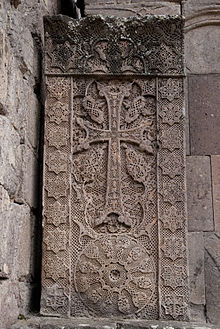
Back خاتشكار Arabic Xatckar AVK Xaçkar Azerbaijani Хачкар Byelorussian Хачкар BE-X-OLD Хачкар Bulgarian Khatxkar Catalan Chačkar Czech Хачкар CV Chatschkar German
| Armenian cross-stones art. Symbolism and craftsmanship of Khachkars | |
|---|---|
 The famous khachkar at Goshavank, carved in 1291 by the artist Poghos | |
| Country | Armenia |
| Domains | Sculpture |
| Reference | 00434 |
| Region | Europe and North America |
| Inscription history | |
| Inscription | 2010 (5th session) |
| List | Representative |
A khachkar (also spelled as khatchkar) or Armenian cross-stone[1] (Armenian: խաչքար, pronounced [χɑtʃʰˈkʰɑɾ], խաչ xačʿ "cross" + քար kʿar "stone") is a carved, memorial stele bearing a cross, and often with additional motifs such as rosettes, interlaces, and botanical motifs.[2] Khachkars are characteristic of medieval Christian Armenian art.[1][3]
Since 2010, khachkars, their symbolism and craftsmanship are inscribed in the UNESCO list of Intangible Cultural Heritage.[4]
- ^ a b The Grove Encyclopedia of Medieval Art and Architecture. — Oxford University Press, 2012. — Vol. 2. — P. 222."'Khatck'ar' [Armen.:'cross-stone'] Typical Armenian stone monument, comprising an upright slab (h. c. 1—3 m) carved with a cross design, usually set on a plinth or rectangular base. "
- ^ Thierry, cover sleeve.Thierry 1989
- ^ Gough M., The Origins of Christian Art, London, 1973
- ^ "Armenian cross-stones art. Symbolism and craftsmanship of Khachkars". UNESCO Culture Sector. Retrieved 2010-11-20.